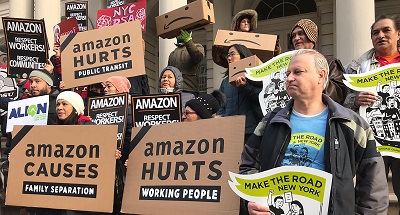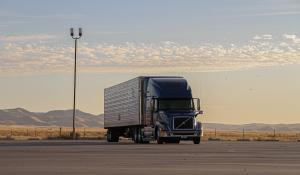
When you're on Amazon, you can accomplish in a few clicks what it might take hours, days or weeks to find elsewhere. But its convenience comes at a high cost. Amazon continues to struggle with worker rights, clean energy, and a market monopoly that harms small businesses.
Green America launched our “Build a Cleaner Cloud” campaign in 2014 to pressure Amazon to use clean energy to power its servers for Amazon Web Services (AWS), a major branch of its business. In 2018, we amended our campaign to call it “Build a Cleaner and Fairer Cloud” as we push Amazon to treat its workers with dignity and pay them fairly.
Amazon has a lot of customers—the Institute for Local Self-Reliance (ILSR) reports that about $1 out of every $2 spent on the internet is spent on Amazon. 105 million households have Amazon Prime memberships. Amazon’s platform is maximized to encourage the easiest and quickest shopping experience: one-click shopping, impulse buys, and easy returns are the direct enemies of the “buy less” and circular economies.
There’s a lot Amazon doesn’t want its customers to consider: like how sometimes, processing returns is too costly—so retailers may opt to trash those returns instead. Return logistics company Optoro reported that five billion pounds of returned items end up in landfills every year. Amazon makes a practice of incinerating its unsold merchandise as well, according to an undercover reporter in the UK.
Here’s why we should quit Amazon:
Worker Rights
Most companies push their employees to be as productive as possible. At the minimum, Amazon workers are being pushed too far, but at worst, the company violates its workers’ human rights.
In its warehouses, Amazon’s “pickers” reach high and squat low to grab orders from bins. Their speeds are tracked by wearable technology. Pickers often report repetitive stress injuries from squatting and lifting, but dizziness, vomiting, and heart attacks have also been reported by Amazon warehouse employees.
Some employees get fired for not meeting quotas when they get injured, or at best, leave with some workers’ compensation benefits. But others aren’t so lucky — 13 Amazon warehouse workers have died on the job in the last six years.
A report by the Center for Investigative Reporting showed that the injury rate in 23 of Amazon’s 110 warehouses is more than double the national average for the industry. Nearly 10 out of every hundred workers at Amazon’s warehouses sustained injuries in 2018, compared with a warehousing industry average of four per hundred.
Warehouse conditions aside, worker rights suffer in all parts of Amazon’s supply chains. Leaked documents from Foxconn, Amazon’s Chinese supplier of smart speakers and other tech items, show that more than 1,000 schoolchildren have been recruited to their factories as “interns.” The documents show these children have been required to work nights and overtime, going against Chinese labor laws.
A Wall Street Journal investigation from October 2019 showed that Amazon is still working with dangerous factories in Bangladesh that other apparel companies have agreed to not work with as part of 2013’s Bangladesh Accord on Fire and Building Safety.
“Amazon seemingly undermines workers’ safety and well-being at every opportunity. It isn’t a coincidence that Amazon sources products from countries with weak labor laws—they are able to get the lowest price and make the highest profit, at the expense of health and safety,” says Charlotte Tate, labor justice campaigns manager at Green America. “We can’t sit by while this corporation exploits people to increase profits.”
Clean Energy
Amazon’s AWS makes up a large portion of the energy Amazon uses— and it uses a lot throughout its supply chain: 44.4 MtCo2E (a measurement of greenhouse gas emissions), compared to 16 MtCO2E used by Microsoft and 1.5 MtCO2E by Google, the other top cloud computing companies, according to a 2020 report by Greenpeace.
Since 2014, Green America has pushed Amazon to use 100 percent renewable energy by 2020 and end the construction of new data centers that rely on fossil fuel or nuclear power. Amazon’s fossil fuel energy demands are comparable in size to a large power company, according to Bruno Sarda, president of the Carbon Disclosure Project. Before our campaign, Amazon was using zero percent renewable energy to power those operations.
Since then, Amazon has contracted construction of 66 renewable energy projects. By the end of 2020, those sites will have the capacity to deliver 3.9 million MWh of energy annually.
In September 2019, Amazon announced it would reach 100 percent renewables by 2030. Its peers Apple and Google have already reached 100 percent renewable energy as of 2014 and 2017, respectively.
In February 2020, Bezos committed $10 billion to fight climate change through a new fund. While we do need big investments in climate solutions, that money will eventually run out. When it does, if Amazon has not addressed its harmful impacts, people and the planet will continue to pay the price.
Monopolizing the Economy
Headlines are most likely to cover Amazon’s growth promises or its labor abuses. But there’s a lot going on behind the scenes that has scholars and legislators concerned.
In 2017 and 2018 Amazon sought bids for HQ2, its much-anticipated $5 billion high-tech hub. It promised 50,000 jobs to the chosen city and suggested cities should compete to give the best counteroffer to the company. Most cities offered free land and tax breaks despite the fact that Amazon paid $0 in taxes on its $10 billion income in 2018 and even collected $129 million back from the government, according to filings from the Securities and Exchange Commission.
Amazon chose the suburbs of Washington, DC, for HQ2, perhaps due to its proximity to Capitol Hill. The company spent $14.2 million on lobbying in 2018, employing 28 in-house lobbyists and using 13 external lobbying firms, according to Bloomberg.
Stacy Mitchell, co-director of ILSR and Amazon expert, testified in July 2019 before the House Judiciary Committee on the monopoly power of dominant tech platforms.
“Amazon is a dangerous kind of monopoly. It doesn’t just dominate markets, it dominates the basic infrastructure for the economy,” says Mitchell.
Amazon is a monopoly because of the way it eliminates competitors and dictates prices. Amazon collects and analyzes data on its sellers. When it sees a seller has a popular product, it creates a similar product, and sells the product at a lower price even it’s at a loss to Amazon. Then, when the seller gives up and goes out of business, Amazon is free to reset its price.
What does lobbying have to do with beating the competition? In the 1970s, business regulations that had addressed monopolies were “redefined to focus on consumer welfare, which is to say, price,” according to New York Times reports. Since then, US regulators have ignored the growing power of Amazon as the European Union has moved to investigate and fine it for violating antitrust laws.
“What we’re moving to is a situation where we don’t really have a market anymore or any semblance of an open market where buyers and sellers can exchange goods on a fair playing field with rules that are set by democratic government,” says Mitchell. “More and more of our transactions are happening in an arena where there’s a kind of private government that controls things. And that private government is Amazon.”

The Bottom Line
Amazon takes away much of the work of shopping with delivery and easy-to-find low prices. But as it undercuts competitors, it eventually will raise its own prices and leave customers no other choices.
In addition to skimping on worker rights, Amazon also slacks on climate progress—it could afford to make changes on all those fronts as it currently enriches its CEO, Jeff Bezos, to the tune of $215 million every day, estimated Business Insider in 2018. The median Amazon employee makes $28,000 per year. It’s easy for shoppers to ignore the problems with Amazon, but as Amazon enters homes through mailboxes, smart speakers, security cameras, and televisions, customer concern is rising.
The movement pushing back against Amazon is gaining momentum. From labor organizers to racial justice organizations and environmental nonprofits like Green America, we’re pushing back and working together as part of the Athena Coalition. Athena’s goal is to stop “Amazon’s growing, powerful grip over our society and economy.” The alliance aims to address community and environmental health, worker safety, surveillance, and threats to democracy that Amazon poses.
Kipchoge Spencer is the founder of Threshold, another nonprofit in Athena. Threshold’s CancelPrime.com educates people on the problems with Amazon and offers alternatives. The campaign aims to get one million people to pledge to stop using Amazon once the threshold is met, in order to have the power of the collective voice to negotiate demands with Amazon.
“Amazon needs us more than we need it and that gives us great power. We think 10-20 million people would be willing to quit Amazon today if they thought it would make a difference,” says Spencer. “Until now, there hasn’t been a way to turn that kind of potential consumer energy into real leverage.”
Take action to rein in Amazon’s greed at GreenAmerica.org, CancelPrime.com, and AthenaForAll.org. We can make progress pushing corporations, but only when we act together.







